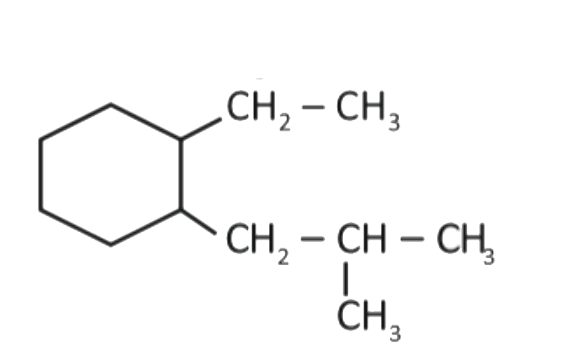The number of primary, secondary, tertiary and quaternary carbons in neo-pentane are respectively,
4, 3, 2 and 1
5, 0, 0 and 1
4, 0, 0 and 1
4, 0, 1 and 1
The correct Answer is:C
To determine the number of primary, secondary, tertiary, and quaternary carbons in neopentane, we first need to understand the structure of neopentane.
1. Identify the Structure of Neopentane:
- Neopentane is a branched-chain alkane with the chemical formula \( C_5H_{12} \).
- Its structure can be represented as:
CH3|CH3−C−CH3|CH3
- In this structure, there is one central carbon atom bonded to four methyl (CH3) groups.
2. Classify the Carbons:
- Primary Carbons: A primary carbon is one that is bonded to only one other carbon atom. In neopentane, the four methyl groups (CH3) are each bonded to the central carbon atom. Therefore, all four of these carbons are primary carbons.
- Secondary Carbons: A secondary carbon is bonded to two other carbon atoms. In the case of neopentane, there are no secondary carbons, as all carbons are either primary or quaternary.
- Tertiary Carbons: A tertiary carbon is bonded to three other carbon atoms. The central carbon in neopentane is bonded to four methyl groups, making it a quaternary carbon, not tertiary.
- Quaternary Carbons: A quaternary carbon is bonded to four other carbon atoms. The central carbon in neopentane fits this definition.
3. Count the Carbons:
- Primary Carbons: 4 (the four CH3 groups)
- Secondary Carbons: 0
- Tertiary Carbons: 0
- Quaternary Carbons: 1 (the central carbon)
4. Final Count:
- Therefore, the number of primary, secondary, tertiary, and quaternary carbons in neopentane is:
- Primary: 4
- Secondary: 0
- Tertiary: 0
- Quaternary: 1
Conclusion:
The answer is:
- Primary: 4
- Secondary: 0
- Tertiary: 0
- Quaternary: 1
- Neopentane is a branched-chain alkane with the chemical formula \( C_5H_{12} \).
- Its structure can be represented as:
CH3|CH3−C−CH3|CH3
- In this structure, there is one central carbon atom bonded to four methyl (CH3) groups.
- Primary Carbons: A primary carbon is one that is bonded to only one other carbon atom. In neopentane, the four methyl groups (CH3) are each bonded to the central carbon atom. Therefore, all four of these carbons are primary carbons.
- Secondary Carbons: A secondary carbon is bonded to two other carbon atoms. In the case of neopentane, there are no secondary carbons, as all carbons are either primary or quaternary.
- Tertiary Carbons: A tertiary carbon is bonded to three other carbon atoms. The central carbon in neopentane is bonded to four methyl groups, making it a quaternary carbon, not tertiary.
- Quaternary Carbons: A quaternary carbon is bonded to four other carbon atoms. The central carbon in neopentane fits this definition.
- Primary Carbons: 4 (the four CH3 groups)
- Secondary Carbons: 0
- Tertiary Carbons: 0
- Quaternary Carbons: 1 (the central carbon)
- Therefore, the number of primary, secondary, tertiary, and quaternary carbons in neopentane is:
- Primary: 4
- Secondary: 0
- Tertiary: 0
- Quaternary: 1
The answer is:
- Primary: 4
- Secondary: 0
- Tertiary: 0
- Quaternary: 1
Topper's Solved these Questions
Similar Questions
Knowledge Check
The number of primary, secondary, tertiary and quaternary carbons in neo-pentane are respectively,
A4,3,2 and 1B5, 0,0 and 1C4,0,0 and 1D4,0,1 and 1The number of primary secondary, tertiary and quaternary carbons in neopentane are respectively.
A4,3,2 and 1B5,0,0 and 1C4,0,0 and 1D4,0,1 and 1The number of primary, secondary, tertiary and quaternary carbons in neo-pentane are respectively,
A4,3,2 and 1B5,0,0 and 1C4, 0,0 and 1D4,0,1 and 1
Primary, secondary and tertiary amines are
View SolutionPrimary, secondary and tertiary amines are
View SolutionNumber of primary, secondary and tertiary hydrogen in the following compound are respectively

View SolutionWhich of the following alkanes contain primary, secondary, tertiary and quaternary carbon atoms together
View SolutionWhich of the following alkanes contain primary, secondary, tertiary and quaternary carbon atoms together
View Solution

